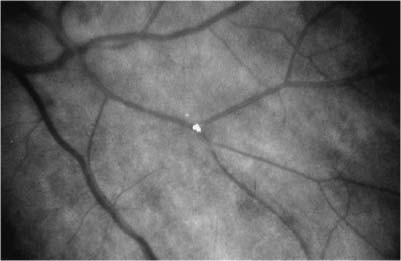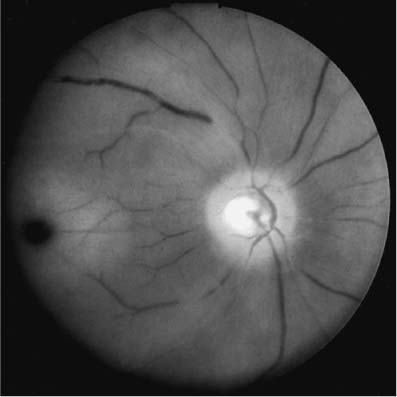Chapter 43 Thromboembolic disease involving the cranial arteries can affect vision in a variety of ways. Disease of the carotid artery and its branches most often affects vision when it involves the retinal circulation, either transiently or by permanent occlusion of the central or branch retinal arteries. When the vertebrobasilar system is involved, the occipital lobes or the ocular motor system may become affected. Emboli from the heart or the aorta can travel through either system. As with stroke in general, most efforts are directed toward preventing additional strokes, whereas treatment options for the acute event are limited. Any stroke, whether it is retinal or cerebral, should be considered urgent (so as to prevent another stroke). The risk of subsequent stroke is usually highest soon after the initial event and then generally decreases over time. In general, recently acquired transient or acute events should be treated emergently, whereas more remote events, such as homonymous hemianopia of months’ duration, can be treated less urgently. Many causes of transient visual loss are benign, but some can be signs of impending stroke; therefore, careful history regarding the nature of the visual loss is critical. Many patients with transient binocular visual loss (see later) interpret their symptom as being monocular on the same side as the homonymous defect. This distinction is very important, although other qualities of the visual symptoms, such as duration or pattern of the visual loss and its recovery, may be helpful. Patient age and associated symptoms and signs should also be used to direct appropriate diagnostic investigations. Transient monocular visual loss from thromboembolic disease tends to last between 1 and 5 minutes (amaurosis fugax). The pattern of visual loss from thromboembolic disease is typically altitudinal (described as a dark curtain or shade), although some patients develop a dark spot in the middle of the vision or they have a constriction of visual field. In any patient with transient monocular visual loss a diligent search for emboli within the retinal vessels must be made. Sometimes digital pressure on the eye during ophthalmoscopy may allow for embolic material, especially cholesterol plaques, to become more easily visible (Fig. 43–1). The presence of cholesterol plaques indicates disease either in the carotid arteries or the aortic arch. Platelet-fibrin emboli, on the other hand, can arise from a variety of sources including the heart, aorta, and carotid arteries. Calcific plaques, which are bright white, suggest cardiac valvular disease. • Brief spells of “visual obscuration” lasting 30 to 60 seconds may be due to optic disc swelling such as with papilledema or an anomalously crowded optic disc. • Monocular spells lasting 15 minutes or longer may be considered “retinal migraine,” but this is a diagnosis of exclusion. • Very rarely, transient, usually prolonged spells of monocular loss or blurring of vision from pigmentary or angle closure glaucoma can be confused with vascular types of visual loss. FIGURE 43–1 Cholesterol embolus in a branch retinal artery. • Dry eye syndrome may cause transient visual blurring, which usually clears after blinking or instillation of lubricating eye drops. • Some patients, especially young people, have transient bilateral dimming of vision with rapid changes in posture. This may be benign or due to dysautonomia. • Intermittent flashing lights and shadows or floaters associated with posterior vitreous separation or retinal detachment. • Various types of retinopathy are associated with profound effects on vision from changes in ambient lighting when going either from bright to dimmer environments or when going from dim to brighter environments. This may also occur in the ocular ischemic syndrome. • Recurrent transient visual loss that has the same pattern and duration suggests the possibility of a hemodynamically significant narrowing of the carotid artery or its branches, whereas recurrent transient visual loss that has a different pattern and duration during each episode suggests embolic disease. Branch retinal artery occlusion causes a permanent visual field defect and is more often associated with embolic disease. Central retinal artery occlusion is associated with acute loss of most of the visual field. In general, it is thought that the retina can remain deprived of blood for a period of 90 minutes before permanent visual loss occurs. Central retinal artery occlusion can also be due to vasculitis, especially giant cell arteritis in the elderly. Acute retinal artery occlusion causes ischemic retinal whitening (although this finding may not develop until several hours after the onset of ischemia), which is in the distribution of the occluded artery in a branch retinal artery occlusion. In the latter the embolus may be visible at the bifurcation of the affected branch retinal artery. In a central retinal artery occlusion, initially the retinal arteries appear thin, and the retinal veins are collapsed (Fig. 43–2). One may see sludging or “box-carring” of the blood within the arteries and especially the veins. When the retina is ischemic, the central pigment in the macula becomes more apparent in contrast to the whitened ischemic surrounding retina, causing a cherry-red-spot appearance. Over days to weeks the retinal blood vessels usually return to normal as the retina regains its normal appearance except for thinning of the retinal nerve fiber layer and the development of optic atrophy, which may develop over several weeks. Emboli are frequently not seen with central retinal artery occlusions because they are thought to impact the retinal artery behind the lamina cribrosa. However, on occasion, the embolus may break up and fragments may be seen in the form of either platelet-fibrin material or cholesterol material in the branches of the retinal circulation. On a rare occasion platelet-fibrin material can be seen to fill many of the branches of the retinal artery, but usually this is present only during the initial event, and, when the clots break up and travel distally, vision may return. FIGURE 43–2 Central retinal artery occlusion.
THROMBOEMBOLIC DISEASE
URGENCY OF EVALUATION
TRANSIENT MONOCULAR VISION LOSS
SYMPTOMS
RETINAL EXAMINATION
DIFFERENTIAL DIAGNOSIS
CENTRAL OR BRANCH RETINAL ARTERY OCCLUSION
SYMPTOMS
RETINAL EXAMINATION
THE OCULAR ISCHEMIC SYNDROME
Stay updated, free articles. Join our Telegram channel

Full access? Get Clinical Tree




